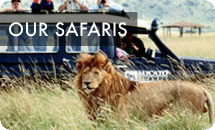Serengeti




 My Safari
My SafariCall a specialist to talk about Serengeti now.
The Serengeti National Park is comprised of mainly treeless savannah and covers an area roughly the size of Northern Ireland. Its Maasai name is Siringitu, which translates as "the place where the land moves on forever" - an excellent description of its vast rolling plains. It is Tanzania's oldest park and supports the greatest concentration of plains game in Africa.
It is here that you will find the great wildebeest and zebra migration involving more than a million animals, and which cross from the Serengeti in Tanzania to the Maasai Mara in Kenya and back again. The wildebeest can walk up to 1000 km during the total migration averaging about 40 km each day. Here in the Serengeti you may also see the black rhino - once close to extinction, but now making a comeback.
No walking is allowed in the northern parks and game viewing is by closed-sided vehicles only, which is not in its favour. Nor is the fact that, like Kenya's Maasai Mara, it is visited annually by huge numbers of people, [cont]
although, unlike the Mara, its huge size does enable these numbers to be accommodated without spoiling the wildlife experience too much. Planning a worthwhile safari here is an art, but at TanzaniaAway we will do all we can to guide you to choose the right camps at the right time of year, and get the best experience possible.
So vast is the Serengeti that it is best considered as split into a number of distinct regions: (1) The Northen Serengeti, mercifully far away from the main tourist area; (2) The Central Serengeti, which is where the greatest concentration of game is to be found (and from where you can take your balloon safari); The Southern Serengeti, the perfect place to find lion and cheetah; and (4) The Loliondo Game Controlled Area, where activities such as night drives, and walking are allowed, unlike in the National Park itself.
The Serengeti's big downside is the Tanzanian government's plans to build a major commercial highway in its northern part, cutting right through the wildebeest migratory route. Although it has been reported (July 2011) that these plans have now been dropped, conservationists remain highly dubious.
Wildlife Highlights:
Although perhaps best known for its annual wildebeest migration, the Serengeti is also host to virtually every other kind of African wildlife.
Buffalo, Elephant, Lion Leopard, Black Rhino, Cheetah, Zebra, Giraffe, Hippo and Ostrich are just a few of these.
The best time to go to (hopefully) follow the wildebeest migration is in December to July, although to see predators in action amongst the other game, June to October is your best bet.
Getting to the Serengeti:
From Arusha, getting to the Serengeti is either a six hours drive or a one hour flight. It is also possioble to drive from Lake Manyara, Tarangire or the Ngorongoro Crater aea.
A popular addition to your stay in the Serengeti National Park is a balloon safari - a lifetime experience not to be missed. Launching at dawn, your balloon rises as the sun rises.
Floating gently over the plains and wildlife of the Serengeti National Park, the flight is for about one hour. After landing, enjoy a traditional champagne celebration and an Out of Africa breakfast prepared and served in the bush.
It is also possible to visit the neighbouring Ngorongoro Crater, Olduvai Gorge, Ol Doinyo Lengai volcano and Lake Natron for its flamingos.





